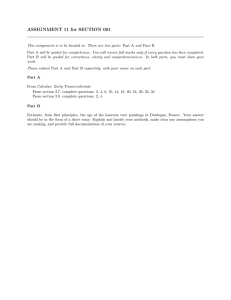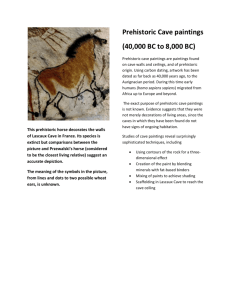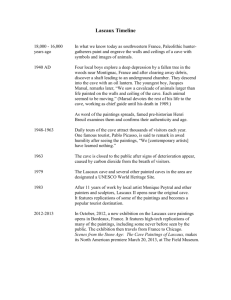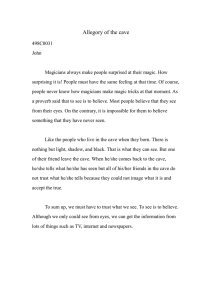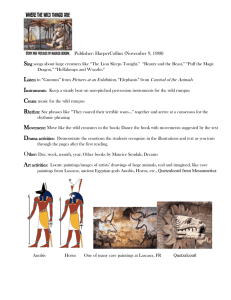Art 3, Weeks 2-3, Prehistoric Art Wednesday
advertisement
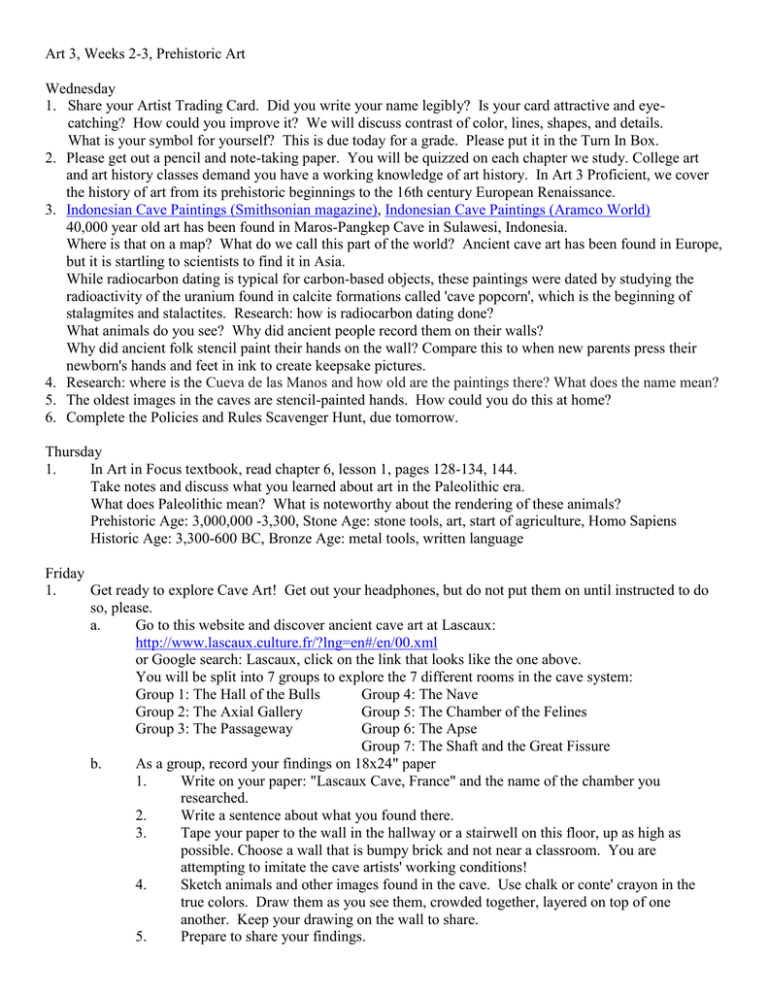
Art 3, Weeks 2-3, Prehistoric Art Wednesday 1. Share your Artist Trading Card. Did you write your name legibly? Is your card attractive and eyecatching? How could you improve it? We will discuss contrast of color, lines, shapes, and details. What is your symbol for yourself? This is due today for a grade. Please put it in the Turn In Box. 2. Please get out a pencil and note-taking paper. You will be quizzed on each chapter we study. College art and art history classes demand you have a working knowledge of art history. In Art 3 Proficient, we cover the history of art from its prehistoric beginnings to the 16th century European Renaissance. 3. Indonesian Cave Paintings (Smithsonian magazine), Indonesian Cave Paintings (Aramco World) 40,000 year old art has been found in Maros-Pangkep Cave in Sulawesi, Indonesia. Where is that on a map? What do we call this part of the world? Ancient cave art has been found in Europe, but it is startling to scientists to find it in Asia. While radiocarbon dating is typical for carbon-based objects, these paintings were dated by studying the radioactivity of the uranium found in calcite formations called 'cave popcorn', which is the beginning of stalagmites and stalactites. Research: how is radiocarbon dating done? What animals do you see? Why did ancient people record them on their walls? Why did ancient folk stencil paint their hands on the wall? Compare this to when new parents press their newborn's hands and feet in ink to create keepsake pictures. 4. Research: where is the Cueva de las Manos and how old are the paintings there? What does the name mean? 5. The oldest images in the caves are stencil-painted hands. How could you do this at home? 6. Complete the Policies and Rules Scavenger Hunt, due tomorrow. Thursday 1. In Art in Focus textbook, read chapter 6, lesson 1, pages 128-134, 144. Take notes and discuss what you learned about art in the Paleolithic era. What does Paleolithic mean? What is noteworthy about the rendering of these animals? Prehistoric Age: 3,000,000 -3,300, Stone Age: stone tools, art, start of agriculture, Homo Sapiens Historic Age: 3,300-600 BC, Bronze Age: metal tools, written language Friday 1. Get ready to explore Cave Art! Get out your headphones, but do not put them on until instructed to do so, please. a. Go to this website and discover ancient cave art at Lascaux: http://www.lascaux.culture.fr/?lng=en#/en/00.xml or Google search: Lascaux, click on the link that looks like the one above. You will be split into 7 groups to explore the 7 different rooms in the cave system: Group 1: The Hall of the Bulls Group 4: The Nave Group 2: The Axial Gallery Group 5: The Chamber of the Felines Group 3: The Passageway Group 6: The Apse Group 7: The Shaft and the Great Fissure b. As a group, record your findings on 18x24" paper 1. Write on your paper: "Lascaux Cave, France" and the name of the chamber you researched. 2. Write a sentence about what you found there. 3. Tape your paper to the wall in the hallway or a stairwell on this floor, up as high as possible. Choose a wall that is bumpy brick and not near a classroom. You are attempting to imitate the cave artists' working conditions! 4. Sketch animals and other images found in the cave. Use chalk or conte' crayon in the true colors. Draw them as you see them, crowded together, layered on top of one another. Keep your drawing on the wall to share. 5. Prepare to share your findings. 2. 3. 4. Read the project in the back of the magazine: Draw Overlapping Animals. We will be using natural pigments, charcoal, and chalk for this project. Discuss the rubric for the painting. HOMEWORK: What animals will choose? Will you use pets, livestock, or wild creatures? What background scene will you use? Take your own photos, please, and bring them in next class. HOMEWORK: please bring a small amount of dirt from your yard to turn into paint and compare to the natural pigments in class. Week 3 1. 2. 3. 5. 6. 7. 8. Share out your Lascaux Cave findings. Why did ancient folk record animals on the wall? Were they real or fantasy animals? Start reading Scholastic Art Magazine, Sept./Oct. 2014: Animals in Art. View the project video: http://art.scholastic.com/issues/09_01_14 Journal entry, Animals in Art: Write about the following on lined paper, please: a. What two or more animals will you use in your artwork? Why these? b. What will you show in the background? c. It would be ideal if you could take and use your own photos. If you cannot, please use fair use/copyright free images. List all websites used for animal and background photos. You may not use 'google images'; list the real website. Review the project rubric below. Draw the animals by looking at the photograph and copying it, NOT tracing it. Both will be drawn on tracing paper so you may get the best composition. Discuss best composition practices. Make a test strip of the natural pigments as seen below. 9. Complete the animal paintings as seen in examples and the Scholastic Art magazine. Essential Standards P.V.2.1 Implement planning to arrive at original solutions to artistic problems. P.V.3.1 Compare properties of tools in the creation of art. P.V.3.2 Analyze the relationship between media, processes, and results. Name Assessor Requirements met Project: Natural Pigments 2+ animal photos as references, accurate contours, shading background photo as reference in accurate contours Informal Balance, focal point, texture, overlapping images Craftsmanship Skillful use of natural pigments, chalks, A 90-100 20 B 80-89 17 C 70-79 15 D 60-69 13 Grade F 0-59 0-12 10 8 7 6 0-5 20 17 15 13 0-12 40 34 30 26 0-25 Artistic Vision and charcoal 3+ animals in accurate contours, amazing details in animals or background, excellent experimental media, substrate, composition, or technique 10 8 7 6 0-5


